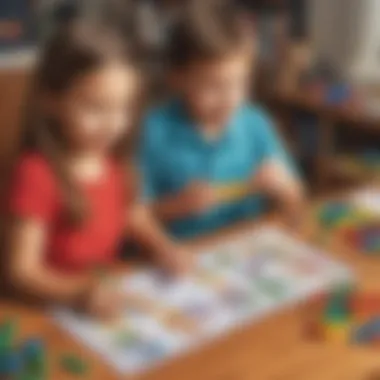Engaging 3-Digit Addition Games for Young Learners


Intro
This article digs into the importance of 3-digit addition math games as educational tools for children in elementary school. These games can be more than just fun; they build crucial arithmetic skills while making learning enjoyable. Incorporating games into lessons helps children grasp complex concepts in a more relatable way. Parents and educators can find beneficial ways to integrate these games into their learning environments, elevating children's mathematical capabilities.
Creative Activities
Craft Ideas
Crafting is a wonderful way for kids to get hands-on with learning. Using simple materials, they can create 3-digit addition games. Here are a few ideas:
- Addition Matching Cards: Create cards featuring different 3-digit addition problems and solutions.
- DIY Number Line: Paint a wooden board to make a number line. Children can use it as a visual aid to solve addition problems.
- Bead Counting Game: Combine colored beads and string to represent different numbers. Each bead can stand for a decimal.
Step-by-Step Guides
To create an Addition Matching Card game:
- Gather materials: cardstock, scissors, and markers.
- Cut the cardstock into equal-sized cards.
- Write various 3-digit addition problems on one set of cards and their answers on another.
- Shuffle and match the problem cards to their answers.
- Play with friends or family.
These activities can foster collaboration and teamwork, essential skills in today's society.
Educational Value
Engaging in these crafting activities provides many educational benefits. Children enhance not only their math skills, but also critical thinking and problem-solving abilities. This hands-on approach makes reasoning easier, while also sparking creativity.
Fun Quizzes
Quiz Topics
The quizzes found on ElemFun cover various topics, including:
- Basic addition principles
- 3-digit addition
- Word problems related to addition
Question Types
Quizzes include various question types, such as:
- Multiple choice questions that test understanding
- Fill-in-the-blank structures to assess knowledge retention
- Scenario-based questions that encourage logic utilization
Knowledge Reinforcement
These quizzes serve as a method for reinforcing school lessons. Children can practice new skills in a low-pressure environment that allows for repetition and active recall, setting the foundation for deeper understanding.
Fact-Based Articles
Topics
Articles available in this category cover numerous subjects impacting understanding, such as:
- The significance of basic math in daily life
- Practical strategies for solving addition problems
- The historical context of numeracy in education
Engaging Content
These articles present information clearly and effectively. The language is simplified for young learners while still being accurate. The visuals and examples in the articles support text comprehension, ensuring material is digestible and interesting.
Understanding the Importance of Math Games
Math is a fundamental skill for young learners. It shapes the way they interact with the world. Using games designed for 3-digit addition adds an essential layer to mathematics education. These games do not only make learning enjoyable; they also promote cognitive development. Young learners engage better with interactive activities. The enhancement of their math skills is greatly supported through fun practices like gaming.
The Role of Games in Education
Games serve as effective educational tools. They create safe environments for learners. Through interacting with games, children can experiment and explore mathematical concepts without the pressure of formal assessment. This kind of learning encourages persistence, as players often try various strategies to solve problems. Moreover, games can foster a deeper understanding of content. In playing, students get immediate feedback. They learn from their mistakes, which is vital in the learning process. Thus, formal learning is complemented with a hands-on approach.
Gamification can enhance retention. Being part of an enjoyable experience, learners can remember concepts better. A study indicated that memory associated with pleasure is often stronger than memory formed through traditional methods alone. This linkage between enjoyment and achievement is critical for effective education, especially at an elementary level. By leveraging this connection, principles can be embedded in the festivities of gaming, thereby making fundamental math concepts like 3-digit addition more intuitive and relatable.
Why Focus on Digit Addition?
Emphasizing 3-digit addition is significant for young learners. It reinforces a key element of mathematics that becomes a foundational skill as they progress. Moving from 2-digit addition to 3 digits can be challenging for them. Thus, focusing on this area ensures a solid grounding before tackling more advanced problems later. Games tailored specifically for this branch of arithmetic can present these challenges in context.


An emphasis on 3-digit addition allows for gradual increases in complexity while maintaining relevance. Memorable experiences built through gaming allows students to build confidence in their math skills. Moreover, being competent in addition helps learners in diverse areas. Skills develop into problem-solving capacities useful across academic subjects and in practical day-to-day situations. Overall, there’s substantial merit in making 3-digit addition a priority, and integrating games can transform potential barriers into pathways for confidence and competence in mathematics.
Types of Math Games for Addition
Math games play an essential role in teaching addition, particularly when it comes to subtly introducing three-digit concepts to young learners. These activities not only improve computational skills but also create a lively and engaging environment where children can thrive. The different types of math games provide varied experiences, catering to different preferences and learning styles. Key elements include the aspect of choice, multi-sensory engagement, and active participation, which all contribute to a more exciting learning journey.
Digital Math Games
Digital math games have become increasingly popular with the rise of technology in education. Platforms offering these games include ABCmouse, Prodigy, and coolmath.com. They provide children with interactive, visually appealing content that makes practicing three-digit addition enjoyable.
One of the main advantages of digital games is their adaptability. Many games can adjust difficulty levels based on the child's performance. Features like instant feedback on answers create an encouraging atmosphere where learners can explore their mistakes without fear of judgement. These programs often include progress tracking tools, allowing parents and educators to monitor advancements closely.
Digital games have a gamified approach that secures engagement while improving math skills naturally.
Moreover, many digital math games support learning beyond addition. They often integrate logic and problem-solving exercises, which enhance critical thinking. Keeping this in consideration allows educators to blend engagement with essential skills through purposeful gaming.
Board Games and Card Games
Board games and card games offer hands-on interaction, which is especially vital for younger learners. Games like Sum Swamp and Math Fluxx contribute to understanding math concepts by adding competitive or collaborative elements. Players often find themselves completing tasks that involve three-digit addition while playing, making learning feel less like a chore and more like fun.
What sets board and card games apart is their social aspect. Children play together, sharing ideas and strategies. They learn turn-taking, patience, and communication skills, all nested within a mastery of math. Moreover, most of these games can be easily adjusted to accommodate learners at varying skill levels. Consequently, they invite inclusion of families in practice, fostering math conversations and promoting a consistent learning rhythm outside traditional settings.
Interactive Activities
Interactive activities approach addition from various angles. These may include hands-on activities like using manipulatives (e.g., blocks, counting chips) or real-life scenarios for practice. This approach strengthens the comprehension of concepts while demonstrating practical applications.
In short, activities such as measuring ingredients for a play kitchen or counting money in fake transactions lend themselves well to signs of mathematical reinforcement in every day like for children. By embedding math in these engaging tasks, the process feels natural.
Games like scavenger hunts that require counting items, or collaborative puzzles that necessitate strategy can keep children enthusiastically engaged. Young learners, drawn in by the playful aspects, often remain unaware of the valuable skills being cultivated throughout the process.
Interactive learning often pairs happiness with effectiveness, anticipating the essential outcome for every math adventure.
Benefits of Using Digit Addition Math Games
Using math games, especially focused on 3-digit addition, provides numerous benefits for young learners. Engaging children in playful interactions while learning helps to strengthen foundational arithmetic skills. It goes beyond mere numbers, creating an environment where students can explore mathematical concepts naturally.
There are several key benefits with particular importance worth discussing:
Cognitive Development
Cognitive development in children is vital, and math games offer an unique approach. When children engage with 3-digit addition games, they not only practice their numeric skills but also enhance critical thinking. Many of these games make kids strategize, analyze, and solve problems, fuelling higher-order thinking.
For instance, when toddlers try to solve scores in a game, they develop estimation abilities. They learn to quickly assess if the answers make sense without always calculating each entirety. This mental flexibility aids in faster thinking, bringing positive outcomes to their learning journey.
Games often provide opportunities for repetition, which is important for mastering skills. Consistent practice in a game context cements knowledge much longer than traditional methods. Games like Prodigy Math adjust to player ability, promoting individual challenge just like one-on-one tutoring. Overall, cognitive skills developed through gameplay prepare children for future complex tasks, exams, and real-world applications.
Engagement and Motivation
This leads us to engagement and motivation as another clear perk of math games. Unlike routine schoolwork, games introduce excitement. Helping young learners stay focused for longer periods relies on capturing their interest. Often, students find enjoyment from competition, challenge, and novelty that games provide.
Attention increases alongside curiosity when strategies begin to kick in. Children become less aware of their effort because they're absorbed in learning. According to study, compelling educational games help maintain focus up to 38% more compared to standard worksheets.
Effective learning comes with a blend of motivation and fun. With rewarding aspects within the game, children get dopamine boosts as they successfully complete tasks. Examples include reaching necessary scores or hitting milestones. This reward system fosters intrinsic motivation, compelling children to attempt even harder challenges not just about winning but about enhancing their skills more broadly.
Collaboration and Social Skills
Lastly, collaboration and social skills play significant roles too, found through 3-digit addition games. While often played in isolation, many math games promote teamwork. Small groups can help create friendly competition while learning together. In this scenario, children learn to share knowledge, offer support, and celebrate each achievement together.
Practicing communication for gameplay discussions heightens social skills. Players must articulate strategies or solve problem errors collectively, thus improving understanding of their peers. Skills entrenched here transfer beyond math teachers to personal relationships and respect for varying thoughts. This group interaction adds a social component that vastly improves overall childhood development.
Engaging in math games fosters collaboration, teamwork, and respect for others, enhancing not only math skills but also emotional intelligence.
Overall, nurturing cognitive abilities, maximizing motivation, and promoting collaboration are significant benefits that using 3-digit addition math games can bring. Incorporatiing these games into a child's learning routine presents an approach rich with rewards spanning various skills that are productive throughout their academia.
Designing Effective Math Games
Designing effective math games is crucial for enhancing the arithmetic skills of young learners. Well-crafted games not only enrich the educational experience but also facilitate deeper understanding of mathematical concepts. Themes of enjoyment and engagement play significant roles when young learners interact with numbers.


Understanding Learning Objectives
Defining clear learning objectives is the first step to designing meaningful math games. For 3-digit addition, the essential objectives include improving addition skills, recognizing number patterns, and fostering critical thinking. These objectives guide the creation of the games, ensuring that they serve educational purposes rather than just passing time. Educators can frame their objectives using topical goals like:
- Competency in adding 3-digit numbers
- Development of problem-solving abilities
- Encouragement of logical reasoning
When learning objectives are specific and measurable, assessing players becomes feasible. It is helpful to revisit these objectives as game results accumulate. This helps track how well the games meet their intended goals.
Incorporating Fun Elements
Games resonate more with children when they incorporate fun elements. These can include unique storylines, appealing characters, and thematic backgrounds. Such components help create an environment that captivates learners and keeps them focused. A few strategies to make math games enjoyable might be:
- Using colorful visuals and animations
- Creating scenarios where numbers solve mysteries or challenges
- Adding rewards or achievements for completing levels
Increasing fun does not distract from learning; in fact, it enhances attention and curiosity. Children learn more readily when they feel enjoyment and excitement during activities. Through these playful experiences, learners find related math skills more appealing.
Adjusting Difficulty Levels
Implementing varying difficulty levels within games is integral for maintaining student engagement. Offering adaptable challenges ensures that every child can succeed at their own pace. This may include introducing progressively complex problems as learners’ skills improve. It aligns with each child's personal learning curve.
To establish these levels:
- Begin with basic problems before gradually increasing complexity.
- Introduce time constraints for advanced players to elevate engagement.
- Create multiple game modes catering unique styles of problem solving.
An adaptable gaming system provides a supportive environment, motivating learners while adequately shining a light on their skill development. Monitoring students' comfort levels with numbers also gives insight into connecting future instruction with identified struggles. These tailored approaches show noteworthy progress in addition proficiency.
In teaching mathematics, understanding that each child brings their own strengths, weaknesses, and treasure troves of potential makes the journey fulfilling yet challenging.
Overall, focusing on effective design makes math games productive tools in teaching. By clearly defining learning targets, making learning enjoyable, and adjusting challenges, educators can engage young learners effectively in mastering 3-digit addition.
Popular Digit Addition Math Games
In the mere landscape of elementary education, the inclusion of math games is paramount. Popular 3-digit addition math games serve an essential role. They not only help in reinforcing the concepts learned but also provide interactive and fun environments for children. With the distraction of technology and the monotony of traditional teaching methods, games act as effective tools for engagement and real learning.
Some specific elements stand out when discussing popular math games. First, they often blend educational goals with play, making the learning both enjoyable and effective. In class or at home, these games can foster a solid understanding of addition while stimulating friendly competition among peers. Parents and educators should consider incorporating these games into routines.
With their interactive nature, these games can also address varying learning styles. Some children may benefit from visual aids, while others might prefer auditory or kinesthetic experiences. By engaging in 3-digit addition games, economics of zone facing becomes simple and avoids over-complication, creating an ideal balance.
Considerations are important too. Not every game fits all objectives. When selecting a game, it is vital to match it with learning objectives. The complexity of addition in a 3-digit scenario necessitates choices that challenge but do not overwhelm young learners. Achieving the right balance between fun and educational value should always be a priority.
Ultimately, popular math games act as gateways to deeper understanding, engagement, and skill proficiency in young learners, transforming the often-daunting task of mastering addition into an enjoyable experience.
Game One: Description and Mechanics
Imagine a game called "Addition Adventure" where players take on challenges to conquer various levels by successfully solving 3-digit addition problems. As they advance from level to level, the difficulty scales up gradually, introducing barriers and exciting elements that relate to storyline progression. This approach allows learners to internalize strategies while feeling motivated to compete and progress.
Game mechanics include steps such as rolling dice to determine the number of problems to solve at each segment. Each solved addition paves the way to new challenges. Things can range from basic problems on pattern cards to group team challenges, where players solve problems collaboratively.
Game One may also employ visual components, like colorful charts mapped out on a board, illustrating rockets or animal journeys that get propelled by successful equations. Here, learning turns real through byte-sized gamified metrics.
Game Two: Description and Mechanics
The second game, "Math Match Duel," introduces an element of probability into the equation laid flat. It mixes memory with skill, where players need pairs of number cards that sum up to a 3-digit target while deploying a fateful mix of chance and skillful addition. Clever design deposits layers into mere matching mechanics, as creating structured sums brings glorious elements into math learning wasted time on trivial matters.
Each player starts with an equal number of cards placed face-down. Players take turns flipping two cards and seek to make their combinations add up to the predetermined 3-digit number displayed on the marker. Players score points by quick accesses while fostering a competitive environment. Adjusting the target allows flexibility for each participant.
This game fosters social interaction, enriching kids’ communication while breaking down concept apprehensions in 3-digit scenarios. Numbers come to life!
Game Three: Description and Mechanics
Lastly, there’s “Puzzle Partners.” In this game, children pair up. Here, common addition puzzles top the fun as two screens splash out scenes of numbers asking strangers across the table to coalesce and complete traditional gain and new bonds. Tasks emerge where each pair collaborates to aid one another in forming new equations or creating series of problems together.
The mechanics enable groups or partnerships where puzzles or incomplete equations trigger endless phrases forming reflection starters on required actionable skill development. Channel surfing through various math problems weaves demands around structured teamwork, presenting math in partnered illustrations firmly for different outputs.
With a focus on social skills and collective outcomes, Puzzle Partners becomes a secured addition to any young learner’s collection fostering supportive exploration mixed with loaded failure-place marks.
Through Games One, Two, and Three, a mosaic of approaches forms in every cyclical learning system applied—each shows myriad possibilities, making math feel less like homework and more about imaginative armature grows across curiosity’s flags.


Assessing Learning Outcomes
Assessing the learning outcomes from 3-digit addition math games is crucial for understanding their educational impact. Through this assessment, educators can determine if students grasp the arithmetic concepts being taught. Educational games not only facilitate learning but also generate valuable data about each child's progress. By analyzing student performance, teachers can make informed decisions on instruction, address individual needs, and enhance the overall learning experience.
Tracking Progress Through Games
When using math games, tracking progress serves as a key factor in evaluating students’ understanding of 3-digit addition. Teachers can systematically document students' performance over sessions. An easy way to track this is via detailed observations or score sheets reflecting individual and group performance.
- Set clear benchmarks for skill assessment from the start.
- Use varied tasks within the games that indicate specific skills being practiced.
- Incorporate both formative and summative assessment methods.
One digital game might record each problem correctly solved and compare it week-to-week. On the other hand, board games may require an observational approach to capture engagement and comprehension effectively. This hands-on monitoring ensures that attention is placed on essential skills and paves the way for targeted improvements.
Evaluating Understanding and Skills
Evaluating student understanding and skills allows educators both to celebrate successes and identify areas needing support. Through 3-digit addition games, teachers can analyze how students apply what they learn in a practical setting. It is essential to look beyond just memorizing facts; focus should be on real-life application and reasoning skills.
Use of questions during or after game play can reveal kids’ thought processes. Here are some ideas for evaluation:
- Reflection activities: Invite students to share what they learned.
- Peer assessments: Encourage kids to evaluate each other’s performance in games.
- Progress charts: Create a visual to showcase improvement over time.
Focus on both accuracy and the process of problem-solving.
Regular evaluation nurtures a growth mindset among children.
Implementing a balanced approach to progress updates helps create a supportive learning environment. Unique insights gleaned from games contribute toward refining teaching strategies and adapting to different learner needs. By integrating both tracking and evaluation methods, educators support a more robust math learning framework.
Integrating Math Games into Curriculum
Integrating math games into the curriculum is a crucial step for enriching the learning experience of young learners. Games break down the often tedious nature of math, especially when dealing with concepts like 3-digit addition. When integrated well, these activities engage students, maximize retention, and foster a love for learning. They can serve as a practical tool to enhance various competencies in mathematics while aligning with educational guidelines.
Math games provide teachers a way to approach teaching 3-digit addition in a more dynamic manner. By making the lessons enjoyable, young learners can feel more confident in their math skills, overcoming any apprehension they might have towards complex arithmetic concepts.
Aligning with Educational Standards
It is vital that any integration of math games aligns with established educational standards. These standards guide curriculum development and assessment practices, ensuring all learners achieve essential skills and knowledge. Incorporating math games, such as those that focus on 3-digit addition, allows educators to learn in depth about beyond 'just playing.' Games can be crafted to meet objectives in both the Common Core State Standards and other national benchmarks, making it easier to assess students’ competencies.
When they use games designed within these frameworks, educators can easily track progress. For example, during a game session focused on addition, teachers can assess not just how many problems a student solves, but also the strategies they choose. This multi-dimensional assessment helps inform future instruction and identifies areas that may need additional support.
Considerations:
- Identify appropriate educational standards relevant to math learning.
- Assess game effectiveness in meeting targeted skills.
- Adjust game mechanics to fit specific age and skill levels.
Creating a Balanced Learning Environment
Creating a balanced learning environment is essential when integrating math games into the curriculum. A successful setup ensures that the engagement through games does not overshadow the foundational goals of education. Balance lies in combining traditional methods with innovative game-based learning.
In a classroom where games are part of the routine, it is crucial to maintain a structured approach. Setting ground rules and clearly defining learning outcomes helps keep students focused. This allows them to see both joy and educational value in these game-based activities.
Moreover, this balance encourages collaboration among students. Through games, learners can work together or compete against each other. This shared experience can nurture social skills alongside mathematical skills. Understanding boundaries within the gaming setup increases accountability and reinforces responsibility in learning.
Key Elements:
- Maintain clear educational goals while using games.
- Structure game time to be both productive and enjoyable.
- Foster collaboration within game play to enhance social learning.
Incorporating math games, particularly those that emphasize 3-digit addition, offers profound advantages in making math skill mastering both attainable and enjoyable. As educational priorities shift towards active and engaging ways to involve learners, it becomes increasingly important to explore and effectively implement these strategies.
Finale
In this article, we discussed the significance of 3-digit addition math games for young learners. It is clear that math games play a vital role in the early education of children. They help in building essential numerical skills while keeping the learning process enjoyable. Such games create a fun learning environment that contributes to a child’s overall development.
Recap of Key Insights
We have reviewed various aspects related to 3-digit addition games, including their types and benefits. The main points include:
- Cognitive Development: Math games stimulate critical thinking and problem-solving capabilities. They present challenges that foster brain growth.
- Engagement: Young learners gain motivation and focus when learning is presented in an interactive manner. Games capture their interest better than traditional lectures.
- Collaborative Skills: Many math games allow for teamwork, necessitating communication and collaboration. This aspect cultivates important social skills in children.
These insights suggest that well-structured math games can effectively help students grasp complex math concepts such as addition with three-digit numbers.
Future Directions in Math Learning
Looking ahead, it is crucial for educators and parents to continually adapt and innovate teaching methods. As technology advances, integrating digital math games into regular curricula provides new and exciting opportunities.
Moreover, continued research in education can guide the development of more effective math games tailored to various learning styles. This is vital as children have different pace of learning.
Lastly, fostering an inclusive learning environment should remain a priority. Engaging all children, regardless of their skill level, ensures that every student benefits from these educational tools. Ultimately, embracing change and innovation in teaching approaches, particularly with math learning, can create better outcomes for young learners in the realm of arithmetic.







